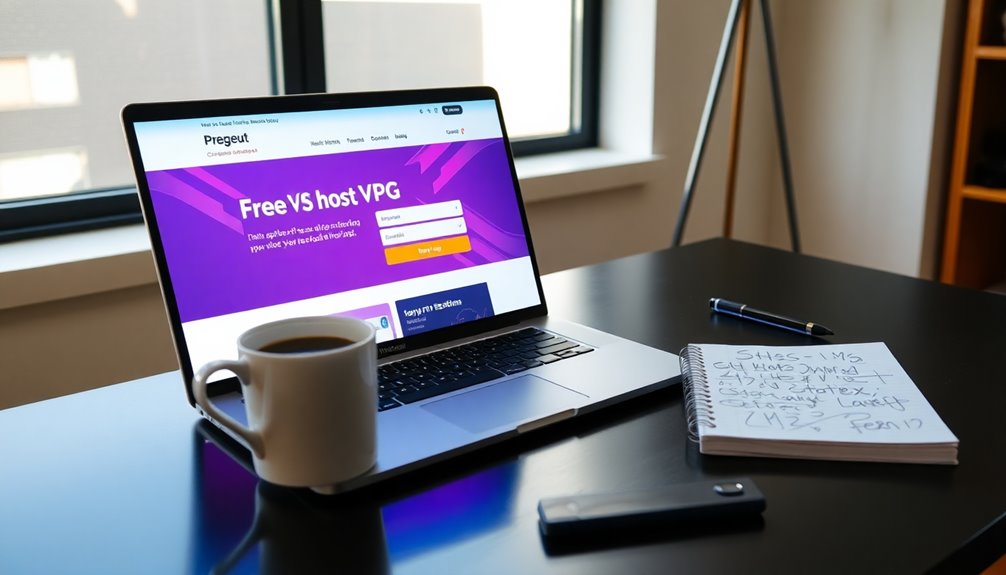To get free VPS hosting, start by choosing a reliable provider like Kamatera or Hostinger that offers trials or money-back guarantees. Next, create an account and confirm your email. Then, select your preferred server location and operating system. After submitting your VPS request, you'll get access credentials via email. Remember, while free options are great for testing, they often come with limitations. There's plenty more to discover about maximizing your experience and making the right choice.
Key Takeaways
- Research reputable providers like Kamatera or Hostinger that offer free VPS hosting trials or money-back guarantees.
- Create an account, confirm your email, and select your preferred server location and operating system during registration.
- Submit your VPS request, which is usually approved within minutes; check your email for access credentials.
- Utilize control panels like cPanel or Plesk for easier server management and optimization of resources.
- Monitor your resource usage regularly to maintain performance and avoid exceeding limitations on free plans.
Understanding Free VPS Hosting

When you explore free VPS hosting, you'll discover that it offers a unique virtual environment that operates independently on a physical server, giving you greater control and performance than shared hosting.
Many free VPS providers use this hosting as a promotional tool, often with limitations on resources or features compared to paid plans.
You'll typically find minimum recommended resources of over 1 GB RAM and 20 GB storage, ensuring adequate performance for your projects.
This setup serves as an excellent learning platform for students and developers, allowing you to test server management and configurations without costs.
However, be cautious of potential security vulnerabilities and limited customer support, as these factors can impact your overall experience with free VPS hosting.
How to Sign Up for Free VPS Hosting

To sign up for free VPS hosting, you'll first want to choose a reputable provider like Kamatera or Hostinger.
Next, complete the registration process by creating an account and activating your free trial through the email link they send you.
Finally, select your preferred server location and operating system to get started with your VPS.
Choose a Provider
Choosing the right provider is essential for securing free VPS hosting that meets your needs.
Look for reputable providers like Kamatera or Hostinger, which offer free trial VPS hosting with no hidden fees.
Start by visiting their websites to explore their free VPS hosting service. You'll need to create an account and provide a valid email address for verification.
After that, select your preferred server configuration, including the operating system options, CPU, RAM, and storage based on your specific requirements.
Once you submit your VPS request, approval typically takes just a few minutes.
Don't forget to check your email for access credentials, which you'll use to connect to your new VPS via an SSH client or remote desktop application.
Complete Registration Process
Signing up for free VPS hosting is a straightforward process that typically takes just a few minutes. Start by visiting the provider's official website, like GratisVPS.net, and create an account with a unique username, valid email, and strong password. After registering, confirm your email through the activation link to activate your account.
Once logged in, you can submit your VPS request, choosing your desired server location and operating system. After you submit, wait for an approval notification, which usually involves a manual check. Upon approval, you'll receive your VPS credentials, including the IP address, username, and password, to connect via SSH clients.
| Step | Action | Notes |
|---|---|---|
| 1. Create Account | Register with username and email | Use a strong password |
| 2. Confirm Email | Click the activation link | Access your dashboard |
| 3. VPS Request | Select server location and OS | Fill out the request form |
| 4. Wait for Approval | Monitor email for notification | Expect a manual check |
| 5. Receive Credentials | Get IP, username, and password | Use with SSH clients |
Activate Free Trial
Activating a free VPS trial is easy and can be done in just a few steps.
First, visit a provider like Kamatera or Hostinger, which offers a 30-day free VPS trial with services up to $100.
Next, create an account by providing a valid email address and a strong password, then confirm your email.
After logging in, select your preferred server configuration, including the operating system and resources.
Submit your VPS request and wait for the approval process, which typically takes a few minutes.
Once approved, you'll receive your VPS credentials, including the IP address and access details.
Now, you can connect via SSH or RDP and start exploring your VPS hosting solutions.
Benefits of Free VPS Hosting Trials

Free VPS hosting trials offer multiple advantages that can enhance your server experience.
With providers like Hostinger and Kamatera, you can test premium features and performance for free, without any financial commitment. Many trials include money-back guarantees, ensuring you can explore services risk-free.
During these free trials, you'll access dedicated resources, including full root access and customizable environments, which greatly improves your server management capabilities.
Plus, robust customer support is often available, helping you navigate any challenges while evaluating the platform.
Utilizing these free VPS hosting trials allows you to assess performance, security, and scalability before committing to a paid plan, making it an essential step for developers and businesses alike.
Limitations of Free VPS Hosting

While free VPS hosting trials provide an excellent opportunity to explore premium features, they come with notable limitations that can impact your experience.
First, you'll encounter resource limitations, including restricted CPU, RAM, and storage, making them unsuitable for resource-intensive applications.
You may also face slower performance and reduced uptime, as many free services offer uptime guarantees as low as 99.5%.
Additionally, the lack of thorough customer support means you'll need to troubleshoot issues with minimal help.
Many providers monetize their services through ads or data collection, which can jeopardize your privacy and security.
Finally, the manual approval processes often delay activation, leading to potential disruptions in your projects.
Trusted Providers for Free VPS Hosting

When you're looking for reliable free VPS hosting, it's essential to take into account trusted providers that offer solid trial options.
You'll want to explore their features and evaluate performance metrics to make certain they meet your needs.
Let's take a closer look at some top contenders that allow you to test their services risk-free.
Top Free Trial Options
Finding the right VPS hosting provider can be challenging, but several trusted options offer free trials to help you make an informed decision.
Here are some top free trial options for you to evaluate:
- Hostinger: 30-day money-back guarantee, starting at $4.64/month.
- A2 Hosting: Fast VPS hosting with a 90-day prorated refund option.
- ScalaHosting: Fully managed VPS hosting with a 30-day free trial.
- Kamatera: Scalable VPS hosting with a 30-day free trial, offering $100 in services.
- Cloudways: 3-day free trial featuring automatic backups and 1-click SSL installation.
These VPS hosting options allow you to explore features and performance before making a financial commitment.
Features of Trusted Providers
Choosing a trusted VPS hosting provider is essential to ensuring your website runs smoothly and efficiently.
Look for features like SSD storage for faster data access and a user-friendly control panel that simplifies server management. A solid uptime guarantee, such as 99.9% or higher, is important to keep your site accessible.
Many reputable providers offer a 30-day money-back guarantee, giving you peace of mind. Full root access is critical for advanced users who need control over their VPS environment.
Consider options like Kamatera, which provides a customizable VPS environment with a 30-day free trial, or ScalaHosting, known for its affordability and managed services.
With these features, you can enjoy free VPS hosting without compromising quality.
Performance and Reliability Metrics
Reliable performance and uptime are essential for anyone considering free VPS hosting.
When evaluating hosting providers, you'll want to focus on key performance metrics and reliability. Here are some top options:
- Hostinger: 100% uptime guarantee, 176ms average response time.
- A2 Hosting: 99.98% uptime, 168ms average response time.
- ScalaHosting: 99.9% uptime guarantee, 443ms average response time.
- Kamatera: 99.95% uptime, 186.77ms average response time with customizable resources during a 30-day free trial.
- Cloudways: 99.98% uptime, 358ms site loading time in a 3-day free trial.
Choosing a provider with solid uptime guarantees and performance metrics guarantees your projects run smoothly and reliably.
Comparing Free VPS Hosting Options

When you're exploring free VPS hosting options, it is crucial to compare the features and guarantees each provider offers. Here's a quick comparison to help you make a decision:
| Provider | Free Trial / Guarantee | Key Features |
|---|---|---|
| Hostinger | 30-day money-back guarantee | Top hosting with reliable support |
| Kamatera | 30-day free trial | Customizable cloud environments |
| A2 Hosting | 90-day prorated refund | Flexible VPS plans |
| ScalaHosting | 30-day money-back guarantee | Managed VPS hosting |
| Cloudways | 3-day free trial | Focus on performance of your website |
How to Optimize Your Free VPS Experience

To get the most out of your free VPS experience, start by selecting a provider that offers a 30-day money-back guarantee, like Hostinger or Kamatera. This way, you can test performance without financial risk.
Here are some tips to optimize your experience:
- Use control panels like cPanel or Plesk for easier server management.
- Regularly monitor resource usage (CPU, RAM, and bandwidth) to maintain performance.
- Leverage automated backup solutions to safeguard your data.
- Engage with community forums for support and shared knowledge.
- Stay proactive in managing your server to enhance its efficiency.
When to Consider Upgrading From Free VPS

Optimizing your free VPS experience is important, but there comes a point when sticking with a free plan can hinder your project's growth. If you consistently exceed resource limits like CPU or RAM, it's time to evaluate an upgrade. Also, if you face frequent downtime or slow performance, your free VPS might not be sufficient anymore. Additionally, investing in a paid plan can significantly enhance your overall project stability and growth potential.
| Signs to Upgrade | Free VPS Limitations | Benefits of Paid Plan |
|---|---|---|
| Exceeding resource limits | Limited performance and speed | Enhanced performance and speed |
| Frequent downtime | Unreliable uptime | Guaranteed reliability |
| Insufficient security | Basic security measures | Advanced security measures and support |
When your project demands better security measures or dedicated support, moving to a paid VPS is advisable.
Common Mistakes to Avoid With Free VPS Hosting

While free VPS hosting can be an appealing option for those on a budget, several common mistakes can undermine your experience.
Avoid these pitfalls to guarantee a smoother hosting journey:
- Assuming all free VPS hosting is reliable: Not all providers are created equal; research thoroughly.
- Neglecting security measures: Implement your own firewalls and backups as many providers lack strong security.
- Overlooking resource limitations: Be aware of CPU, RAM, and storage caps that can affect performance.
- Failing to read terms and conditions: Understand usage restrictions to prevent account suspensions.
- Ignoring customer support availability: Check the support options, as many free accounts receive minimal assistance.
Frequently Asked Questions
Is It Possible to Get Free VPS?
Yes, it's possible to get free VPS hosting, but with some caveats.
Many providers offer free trials, allowing you to test their services without paying upfront. For instance, Kamatera gives you $100 worth of services for 30 days.
However, remember that free options often lack performance and resources, making them best for testing or learning.
Plus, be cautious about hidden costs or privacy risks when choosing a provider.
How to Access Gratisvps?
To access GratisVPS, start by visiting their official website at GratisVPS.net.
You'll need to create an account, so choose a unique username, provide a valid email, and set a strong password.
After that, confirm your email by clicking the activation link they send you.
Once your account's active, log in, request a VPS by selecting your preferred server location and OS, and wait for approval via email.
Does Google Offer VPS?
So, you're wondering if Google offers VPS? Well, grab your popcorn because it's a cloud comedy!
Google doesn't provide traditional VPS, but you can create virtual machines through Google Compute Engine, which is pretty much a fancy VPS in disguise.
With their free tier, you can dabble in cloud magic, getting a tiny instance to play with.
Just remember, once you hit the limits, the fun might cost you—so keep an eye on those numbers!
Can I Make My Own VPS Server?
Yes, you can definitely create your own VPS server!
By using virtualization software like VirtualBox or VMware, you can allocate resources on your physical machine to simulate a virtual server.
Alternatively, if you're tech-savvy, you can install server software like OpenVZ or KVM on a dedicated server or a powerful PC running Linux.
Just make certain your internet connection is reliable to guarantee peak performance for your self-hosted VPS.
Conclusion
To sum up, free VPS hosting can be a fantastic way to flourish your projects without financial fuss. By understanding your options and optimizing your experience, you'll find a suitable setup that suits your needs. Just remember to recognize the risks and limitations involved, and avoid common pitfalls. If you play it smart and stay savvy, you might just discover the perfect platform to propel your ambitions forward. Happy hosting!









